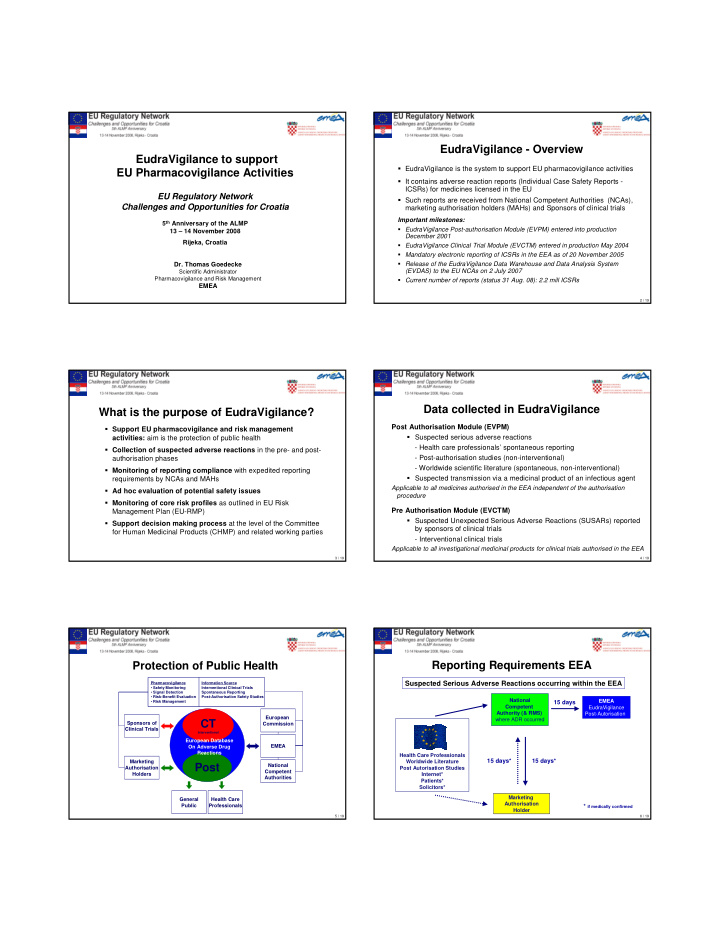



EudraVigilance - Overview EudraVigilance to support � EudraVigilance is the system to support EU pharmacovigilance activities EU Pharmacovigilance Activities � It contains adverse reaction reports (Individual Case Safety Reports - ICSRs) for medicines licensed in the EU EU Regulatory Network � Such reports are received from National Competent Authorities (NCAs), Challenges and Opportunities for Croatia marketing authorisation holders (MAHs) and Sponsors of clinical trials Important milestones: 5 th Anniversary of the ALMP � EudraVigilance Post-authorisation Module (EVPM) entered into production 13 – 14 November 2008 December 2001 Rijeka, Croatia � EudraVigilance Clinical Trial Module (EVCTM) entered in production May 2004 � Mandatory electronic reporting of ICSRs in the EEA as of 20 November 2005 � Release of the EudraVigilance Data Warehouse and Data Analysis System Dr. Thomas Goedecke (EVDAS) to the EU NCAs on 2 July 2007 Scientific Administrator Pharmacovigilance and Risk Management � Current number of reports (status 31 Aug. 08): 2.2 mill ICSRs EMEA 2 / 19 Data collected in EudraVigilance What is the purpose of EudraVigilance? Post Authorisation Module (EVPM) � Support EU pharmacovigilance and risk management � Suspected serious adverse reactions activities: aim is the protection of public health - Health care professionals’ spontaneous reporting � Collection of suspected adverse reactions in the pre- and post- - Post-authorisation studies (non-interventional) authorisation phases - Worldwide scientific literature (spontaneous, non-interventional) � Monitoring of reporting compliance with expedited reporting � Suspected transmission via a medicinal product of an infectious agent requirements by NCAs and MAHs Applicable to all medicines authorised in the EEA independent of the authorisation � Ad hoc evaluation of potential safety issues procedure � Monitoring of core risk profiles as outlined in EU Risk Pre Authorisation Module (EVCTM) Management Plan (EU-RMP) � Suspected Unexpected Serious Adverse Reactions (SUSARs) reported � Support decision making process at the level of the Committee by sponsors of clinical trials for Human Medicinal Products (CHMP) and related working parties - Interventional clinical trials Applicable to all investigational medicinal products for clinical trials authorised in the EEA 3 / 19 4 / 19 Protection of Public Health Reporting Requirements EEA Suspected Serious Adverse Reactions occurring within the EEA Pharmacovigilance Pharmacovigilance Information Source Information Source • Safety Monitoring • Safety Monitoring Interventional Clinical Trials Interventional Clinical Trials • Signal Detection • Signal Detection Spontaneous Reporting Spontaneous Reporting • Risk-Benefit Evaluation • Risk-Benefit Evaluation Post-Authorisation Safety Studies Post-Authorisation Safety Studies National EMEA • Risk Management • Risk Management 15 days Competent EudraVigilance Authority (& RMS) Post-Autorisation European where ADR occurred CT Sponsors of Commission Clinical Trials interventional European Database EMEA On Adverse Drug Reactions Health Care Professionals 15 days* 15 days* Marketing Worldwide Literature Post National Authorisation Post Autorisation Studies Competent Holders Internet* Authorities Patients* Solicitors* Marketing General Health Care Authorisation Public Professionals * if medically confirmed Holder 5 / 19 6 / 19
Reporting Requirements non-EEA EU Risk Management Plans and EudraVigilance Suspected Serious (Unexpected) Adverse Reactions occurring outside the EEA � Electronic interface between EU-RMP and EudraVigilance � Monitor identified and potential risks and important missing National information as outlined in the EU-RMP Safety Specification Competent � Integration of core risk profile in Reaction Monitoring Reports Authority EMEA EudraVigilance generated in EudraVigilance to support pharmacovigilance activities for Post-Autorisation centrally authorised products Health Care Professionals � Risk monitoring (identification and characterisation) Worldwide Literature Post Autorisation Studies � Evaluation of the effectiveness of risk minimisation measures Internet* 15 days* Patients* � The interface between EU-RMP and EudraVigilance is a living Solicitors* 15 days* document due at � Submission of final version of EU-RMP at time of CHMP Opinion � Each time the EU-RMP is updated in the future Marketing Authorisation * if medically confirmed Holder 7 / 19 8 / 19 EudraVigilance Data Processing EudraVigilance System - Functions � Data processing network interlinking all National Competent Authorities in the EEA, the European Commission and the EMEA ICSR ICSR spontaneous EVPM spontaneous to exchange information in pharmacovigilance User Management EV Organisation � Electronic data exchange of adverse drug reaction reports in line Gateway with ICH standards (International Conference of Harmonisation of ICSR NCA ICSR Report Technical Requirements for Registration of Pharmaceuticals for Report intervention EVCTM MAH intervention EVDAS Human Use) Sponsor � Unique repository of EU and non-EU adverse drug reactions for development and authorised medicinal products AMP � Incorporates the international medical terminology AMP IMP EVMPD IMP Medical Dictionary for Regulatory Activities (MedDRA) EU RMP ICSR = Individual Case Safety Report AMP = Authorised Medicinal Product 9 / 19 IMP = Investigational Medicinal Product 10 / 19 General Aspects of Signal Detection EudraVigilance Reaction Monitoring Report � Signal Detection describes a routine review of all ICSRs reported � Reaction Monitoring Report is generated based on: to EudraVigilance: � All spontaneously reported ICSRs over the last 15 or 30 days to EVPM � For each product under monitoring all reactions reported within defined � Generated at active substance level timeframes are listed for each System Organ Class � All reports flagged as “suspect” and “interacting” by sender � Reviewed by scientific staff at the EMEA in collaboration with � List of reactions (MedDRA Preferred Terms) for each product at Rapporteur/Co-Rapporteur substance level, ranked by System Organ Class (SOC) indicating � ‘Signals’ are based on statistical algorithms (e.g. Proportional � New cases/fatal cases associated with reaction Reporting Ratio: an event is relatively more often reported for a � Total number of cases medicinal product compared to the number of reports of this event for � Origin (EU/non-EU) of cases all other medicinal products in the database) � Proportional Reporting Ratio (PRR) and 95% Confidence Interval � Each signal requires careful medical evaluation to be confirmed as � Signals of Disproportionate Reporting (SDR) are highlighted in red if causally related with the product � N ≥ 3 and � Lower bound of 95% Confidence Interval of PRR ≥ 1 11 / 19 12 / 19
Recommend
More recommend